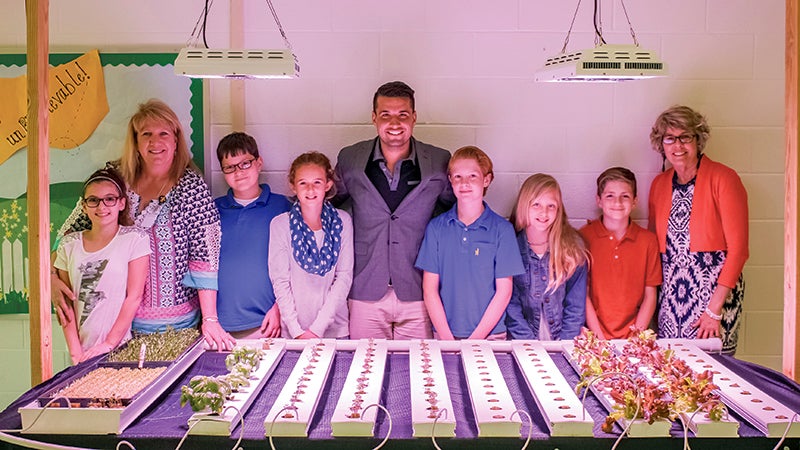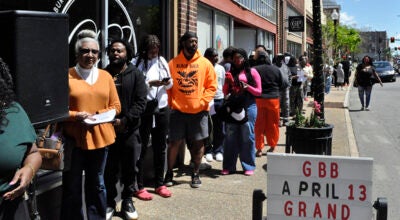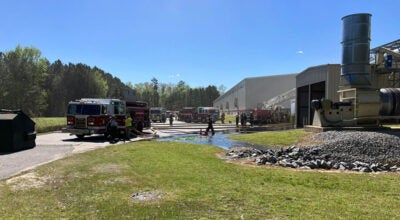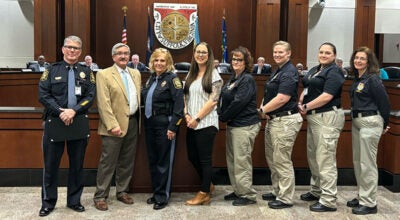NSA project growing on staff and students
Published 9:48 pm Tuesday, May 9, 2017

- Nansemond-Suffolk Academy fifth-grade math and science teacher Mary Dewing, Neighborhood Harvest president Thomas Vandiver and Lower School science resource teacher Cindy Mears stand behind the school hydroponics garden with fifth-grade students Vanessa Brooks, 11, Derrick Baughman, 10, Rylea Nelms, 11, Griffin Strange, 11, Alyssa Bossick, 10, and Ethan O’Leary, 11.
A Suffolk entrepreneur recently provided a tool for conservation lessons at Nansemond-Suffolk Academy.
NSA students are learning more about conservation with a hydroponic garden at their main campus on Pruden Boulevard. The garden was donated by Thomas Vandiver, the president of Neighborhood Harvest in Suffolk.
It represents the culmination of conservation studies for NSA fifth graders this semester. Teachers were interested in building a greenhouse for lessons but were concerned about cost and maintenance.
“We realized the materials and the maintenance were going to be out of our league,” said NSA Lower School science resource teacher Cindy Mears.
Vandiver designed and built a hydroponic garden worth several thousand dollars at no cost to the school. He introduced the garden to the school in April and has since been educating both the students and the teachers on maintaining it.
“We’re learning with the students,” Mears said. “It’s a learning process for all of us.”
Hydroponics allow plants to grow without soil using water with added mineral nutrients. The seeds are wrapped in composite wool and receive light from full spectrum growth LEDs. A 40-gallon container of recyclable water is replaced weekly.
It’s the same method that Neighborhood Harvest uses to grows produce at its Suffolk greenhouse.
“It’s a small-scale version of everything we do at our farm,” Vandiver said.
He has used the garden to teach fifth-grade NSA students about hydroponics and the history of the technology.
“You can talk about conservation and what it means, but something like this gets them real excited,” he said.
The lessons made an impression on the students.
“He explained it so well,” said 11-year-old NSA student Rylea Nelms.
Some of the students learned about the opportunities of hydroponics for less hospitable environments, both on and off Earth.
“I learned that even though it may be a desert place, you can still grow farm produce using hydroponics,” 10-year-old Derrick Baughman said. “It also helps space travel, and everything it can do to colonize another planet.”
Students help maintain the garden under the supervision of teachers. They harvest lettuce, basil, peas and other vegetables for the school cafeteria.
Fifth-grade math and science teacher Mary Dewing said the plants grow more than 30 percent faster than in the garden.
“It’s truly shocking how fast it grows,” Dewing said.
The taste buds of both students and teachers were impressed.
“I thought it was so much better than something you grow outside,” Rylea said. “It was so fresh.”
These students get the vegetables after all of their work tending the garden, and some find their flavor that much better for it.
“You might make better choices at lunch since you got to grow it,” said 11-year-old Vanessa Brooks. “You might want to have it more than you would before.”
The hydronic garden will be maintained for use this summer and the fall semester, when students will participate in experiments such as changing the colors of the LEDs.
“We’ll see the impact of different wavelengths of lights on the plants,” Vandiver said.
Mears said one of the goals is for students to be inspired and develop their own ideas for the garden.
“We’re hoping the kids will come up with their own experiments they want to try,” she said.
The project has been positive and memorable for students, Dewing said.
“They’ll remember this experience as probably one of their favorites from fifth grade,” she said.





